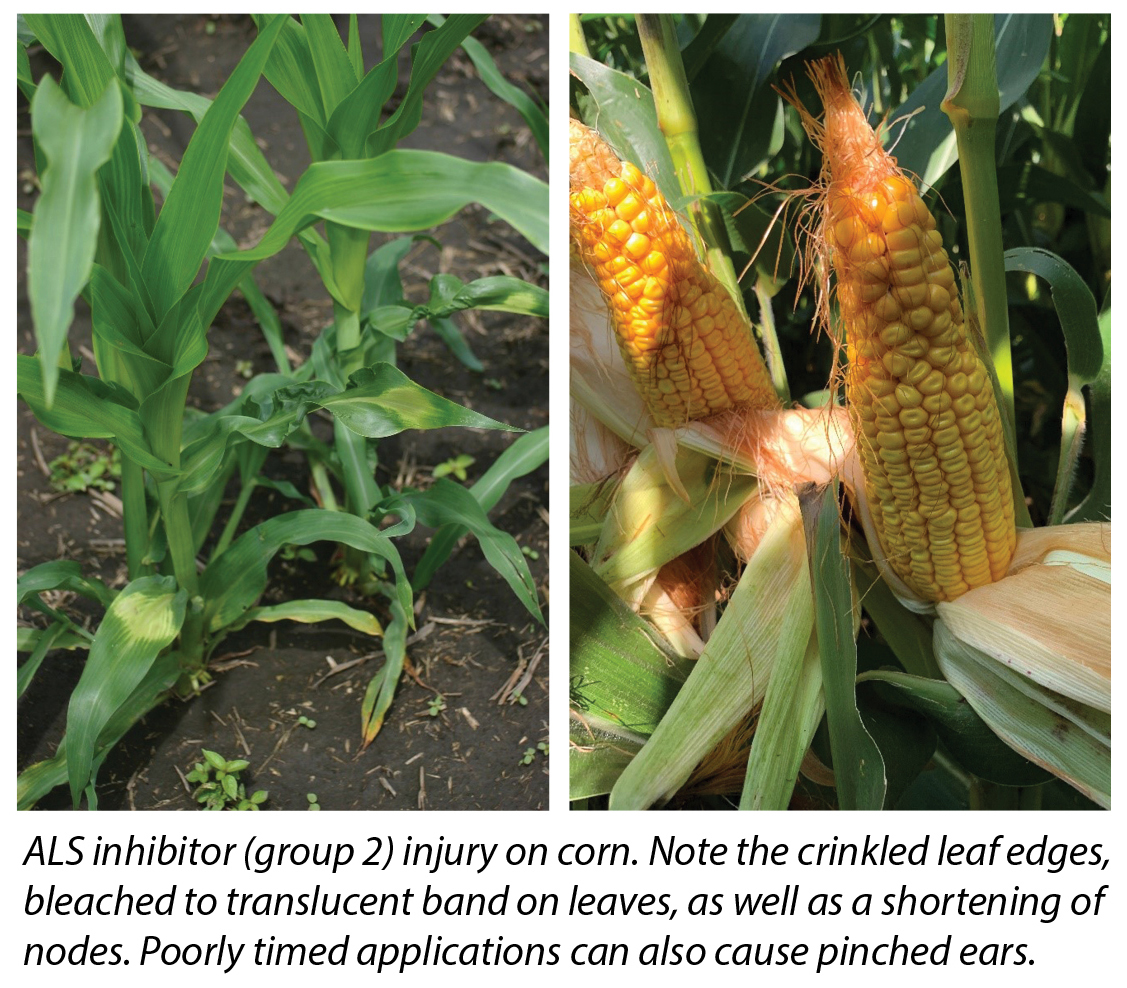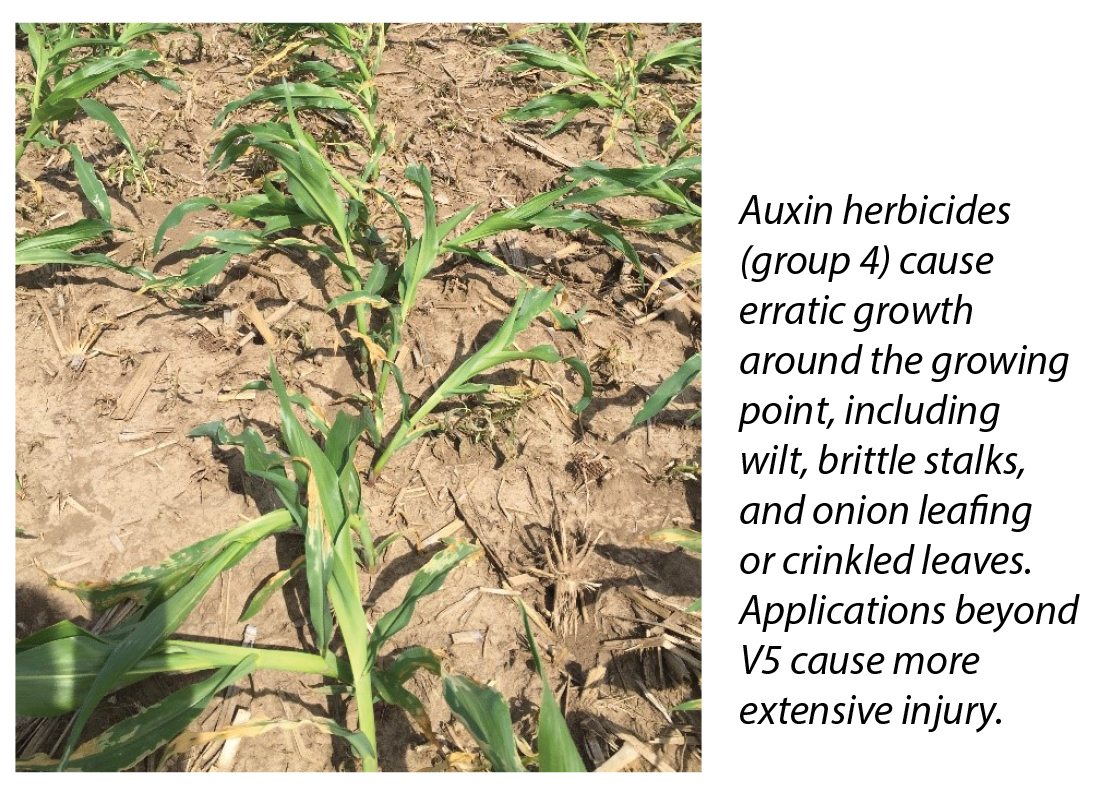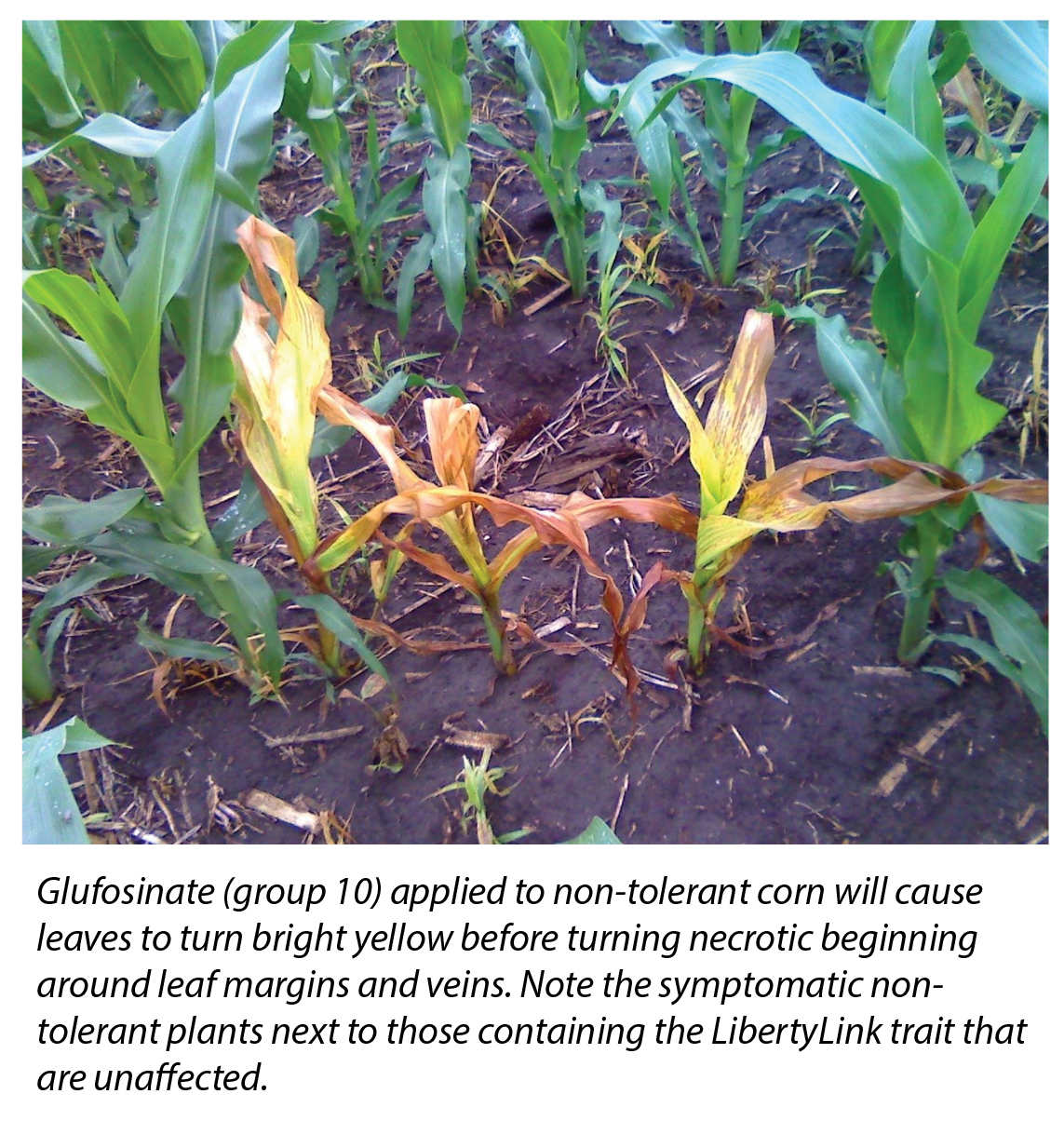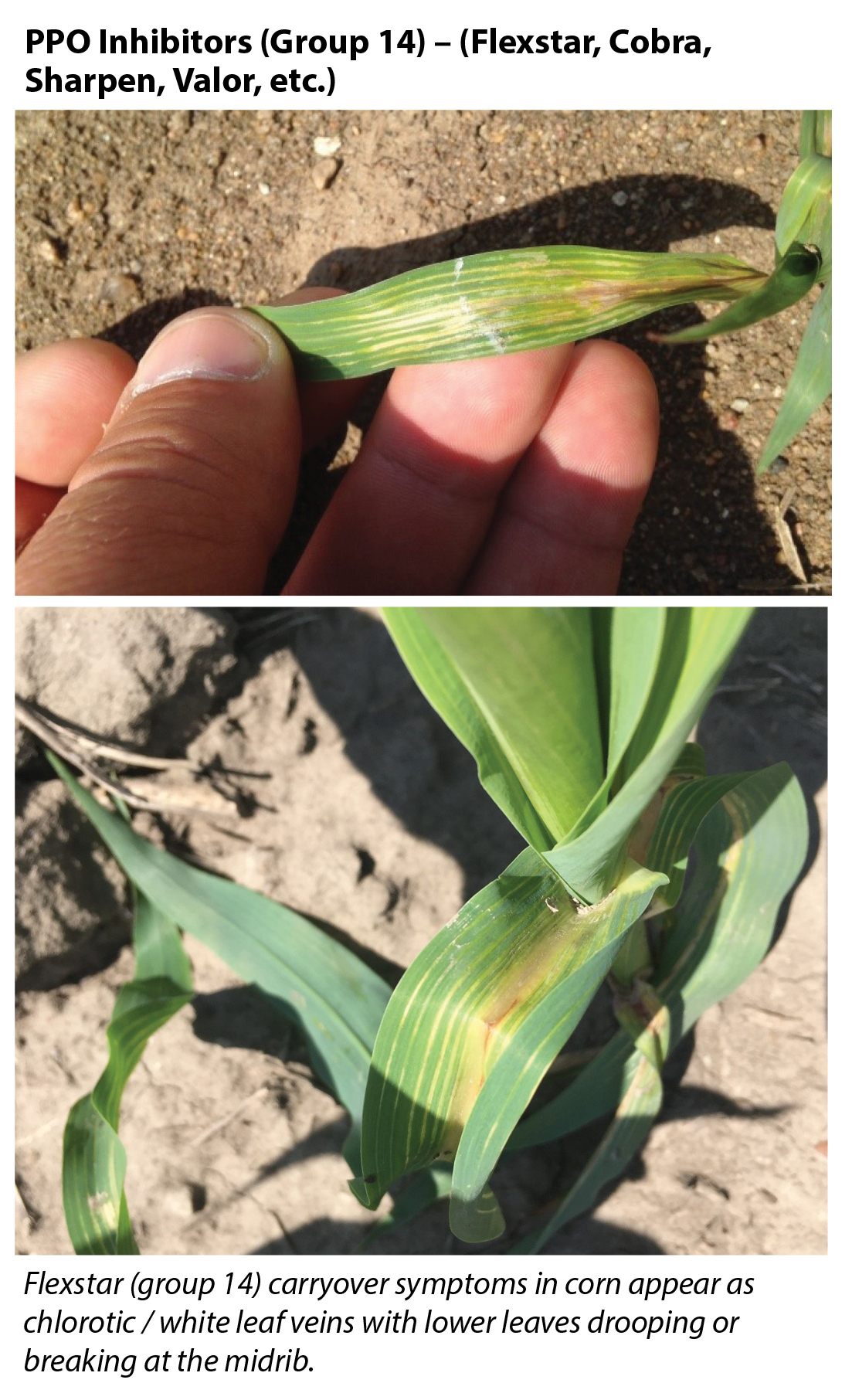Herbicide Injury
Herbicides are an important component of producing high-yielding corn, but they also bring some risk of crop injury either from herbicide carryover from the previous year or herbicides used in-season. Being able to diagnose herbicide injury is important to troubleshoot the root cause and to prevent issues in the future. It is also important to distinguish between herbicide injury and disease and abiotic stresses. This Wyffels Between the Rows discusses how to diagnose corn herbicide injury symptoms and how to prevent injury in the first place.
The most common types of herbicide injury in corn are (1) herbicide carryover in the soil from previous years (2) tank contamination (3) drift from neighboring fields (4) too high of herbicide rates or poor weather conditions after application that amplify symptoms.
Some tips for diagnosing corn herbicide injury in the field include looking for any patterns in the field:
§ Herbicide carryover symptoms often are not consistent throughout the field and look patchy. Looking for areas where the sprayer may have overlapped the prior year can be helpful in diagnosing herbicide carryover.
§ Tank contamination can be challenging to diagnose as rates may have been very low. Looking for V-shaped boom cleanout patterns where the sprayer started in the field may be helpful.
§ Drift from neighboring fields often tapers off as you move away from the field edge.
§ Too high of herbicide rates may cause consistent symptoms across fields, but it is more common in areas where the booms of the sprayer may have been loaded, when the sprayer slowed down too quickly, or in overlapped areas.
§ Look for any weeds growing in the field or around field margins. They can provide clues into what herbicide(s) caused issues by showing similar symptoms.
Pay attention to where symptoms occur on the plant as well. If symptoms are in or around the growing point or new growth, the herbicide causing injury is likely a systemic product. If new growth is unaffected but older growth has damaged or dead tissue or spots, they were likely caused by a contact herbicide.
Crop Safety
Corn can tolerate labeled herbicides by several methods, with metabolism being one of the most common. Corn can quickly degrade many herbicides into non-lethal compounds following application. If plant metabolism is slowed by stressful weather conditions, many commonly used herbicides can cause crop injury. Large temperature swings or drought stress can decrease plant metabolism which also increases risk of crop injury. If stressful conditions are present or expected, sometimes it is best to wait a few days on application until the stressful conditions subside.
If stressful conditions persist, other measures such as switching herbicides may be required. Safeners are included with some herbicide formulations to reduce crop injury potential, but they aren’t failsafe in all conditions.
Consider the following management practices to reduce the risk of crop injury to herbicides:
§ Apply herbicides prior to the V5 corn growth stage.
§ With late applications, use drop nozzles to reduce the amount of herbicide entering the corn whorl.
§ Properly maintain and calibrate sprayers.
§ Check herbicide labels for any restrictions or concerns with tank-mixing other products.
§ Avoid herbicide application when the corn plant is under environmental stress.
§ Avoid application directly before or after expected large swings in daily temperature.
§ Avoid application when the sum of daily high and low temperatures is less than 90 degrees.
§ Avoid applications of growth regulator herbicides during periods of rapid corn growth.
§ Only use label-recommended additives.
§ When tank mixing herbicides, always follow the label with the most restrictive directions of use.
Herbicide Symptomology
ACCase Inhibitors (Group 1) – Grass Killers (Assure, SelectMax, Post, etc.)
The ACCase inhibitors are selective herbicides that kill grasses by affecting fatty acid synthesis. Symptoms will show up 2-4 days after application and gradually worsen for several weeks. Leaf chlorosis and necrosis occurs in youngest growth first. Pulling out the whorl of the corn plant and any grassy weeds will be easy to do, revealing that the growing point at the base of the whorl is brown and mushy. Broadleaves will be unaffected.

ALS Inhibitors (Group 2) – (Pursuit, Accent, Harmony, etc.)
The ALS inhibitors affect amino acid production and control grasses, broadleaves, or both depending on the product. There are numerous ALS inhibitors labeled for use in corn. Since the ALS inhibitors affect amino acid production, the symptoms first appear on new growth or around the growing point within 4 days of application with symptoms worsening over the course of 2 weeks. The growing point will become chlorotic with a shortening of internodes. Other symptoms include a yellow leaf flash, translucent band across leaves, and crinkled leaf edges. Corn ears may have a pinched appearance as well. If roots are dug, affected plants may have a bottle-brush appearance to the roots.

Auxin Herbicides (Group 4) – (2,4-D, Dicamba, Stinger, etc.)
The synthetic auxins are products that mimic plant hormones and cause erratic growth. Symptoms will appear around growing points of plants and can become obvious in as little as a few hours to over a week after application. Corn symptoms include wilt, onion-leafing, brittle stalks, and erratic brace root growth. Applications of labeled auxin herbicides to corn should not be made past label cut-offs, as corn larger than V5 is more sensitive to injury from auxin herbicides.

Glyphosate (Group 9) – (Roundup, etc)
Glyphosate is a non-selective herbicide that affects amino acid production, meaning symptoms show up near the growing point of affected plants in 3 to 10 days. Plants without tolerance to glyphosate will become chlorotic and eventually necrotic starting around the growing point. In some cases, a purpling may occur to leaf veins and a white to translucent band might be apparent across some leaves.

Glufosinate (Group 10) – (Liberty, Ignite, etc.)
Glufosinate is a non-selective herbicide that affects all plants without the LibertyLink trait. The herbicide causes ammonia to accumulate to lethal doses in the plant cells which ultimately causes cells to be destroyed. Symptoms can occur within a day up to several days after application, beginning as bright yellow leaves before tissue becomes necrotic around leaf margins and veins.

PPO Inhibitors (Group 14) – (Flexstar, Cobra, Sharpen, Valor, etc.)
PPO inhibitors affect chlorophyll production which ultimately causes cell membrane disruption which causes necrotic tissue to develop within several days after exposure. Chlorotic / necrotic spots may develop on leaves where droplets landed.
Corn is sensitive to herbicide carryover from PPO inhibitor applications as well, especially applications of Flexstar (fomesafen) made late in the previous year and in dry years. These carryover symptoms will appear as chlorotic / white leaf veins with lower leaves drooping or breaking at the midrib. This is one of the most commonly observed herbicide carryover issues.

Pigment Inhibitors (Group 27) – (Callisto, Laudis, Impact, etc.)
Pigment inhibitors affect pigment production within plants, meaning affected plants lose color and develop a bleached appearance which first starts to appear on new leaves. Bleached leaf tissue develops within a few days after exposure. These herbicides also have soil activity, meaning stunted plants and poor emergence can occur as well when exposed as seedlings. If corn plants are stressed or exposed to a high rate, they can show symptoms as well but typically recover once conditions improve and the plant can metabolize the compounds.

For more information, South Dakota State University has a comprehensive guide to corn herbicide injury.
